Freedom of the Press for Students?

Graphic by Erika Zelaya ’15 and Mia Field ’15
When students read The Chieftain news site, articles have gone through a multi-tiered approval process.
A free press is one of the founding values of American culture; it allows us to expose wrongdoings, endorse certain views, and keep the public informed— but does everyone have that right? Do you have that right when you walk through the doors of Wakefield High School?
The removal of a story in a publication, or a journalistic spike, doesn’t happen very often in major publications; it typically occurs when there’s a sudden change in events rendering the article inaccurate, or when an article makes the publisher look bad explained Mr. Burns, a previous Journalism teacher and current veteran English teacher at Wakefield. In a high school newspaper spikes happen fairly regularly.
The Chieftain has had 3 stories spiked in the 2 years it has been an online news site. In one instance, an article on a recent sexual assault was returned because of safety concerns for the student. In another, an article about senior project was rejected because faculty believed that the author didn’t have enough credibility to write on the subject.
While everyone is entitled to Freedom of Speech, it can be restricted in certain areas. For example, if you went to a restaurant and began using extremely vulgar language, they could ask you to leave; the same thinking applies to school newspapers. Although students have first amendment rights, while they are in a school building some of those rights are limited. You won’t go to jail for writing a story on teen pregnancy, but the school could decide how to handle the repercussions.
Stories of spiking and censorship in school newspapers have plagued the country for years. In 1988 the Supreme Court made the Hazelwood vs. Kuhlmeir decision which ruled that administrators who oversee high school newspapers do have the right to censor news publications if they are sponsored by the school; thus, stories began to be pulled throughout the nation.
Recently, the Principal of Fauquier County High School pulled an article regarding a new marijuana-trend termed “dabbing.” This sparked outrage and was featured in many major publications including The Washington Post. Although many were upset, The Post wrote that, “The Student Press Law Center said the censorship was probably legal.” The Hazelwood vs Kuhlmeir decision allows principals to remove articles they deem unacceptable for school.
According to the Student Press Law Center Hazelwood “requires school officials to demonstrate some reasonable educational justification before they can censor anything.” This means school administrators can’t ban, censor, or spike articles willy-nilly, and if they do, students have a right to try the case and even take it to court.
In schools across the states there’s a practice known as “prior review.” This practice requires an administrator to sign off on articles before they can be published. To get an article into The Chieftain a writer must go through a series of steps. First, the writer must come up with a story idea and complete their research. Once they’ve researched they have to get quotes from interviewees and compile all their data. They then take the written article and have to get it edited by the page editor, and sometimes the editor in chief must also look at the story. Once it passes this stage, the author uploads it to the whschief.com cite. If it makes it past the newspaper adviser, Ms.Wathen, it is then able to be delivered to our school administrator, Mr. Laurie, who approves the articles to be published. The adviser, then pushes the articles to the site.
While there have been exceptions for shorter articles on exciting games and even some longer feature articles, typically, an author must submit their story by Monday at 8am to have it published by Friday. If the administration feels that an article is inappropriate for school, then they have the authority to reject it, request a revision, or remove parts that they don’t deem acceptable for a high school setting.
A school sponsors a journalism class, pays for a domain, and pays our adviser; this gives them say in what goes in and out and when.
In order for a paper to be exempt from these rules it must be labeled as a “public forum for student expression.” This would mean that the school granted the editors of the paper full discretion about what gets printed. The only way these can be regulated is if the topics of an article are illegal or pose a safety threat.
“The school has every right to spike any article they want,” said Mr. Burns. He said that since the school sponsors the newspaper they must act as a parental figure and the parental figure should be able to control what goes in and out.
As students across the country continue to fight for their first amendment right, new questions emerge: Are students responsible enough to control what gets published? Who is protected by Freedom of Speech?
How do YOU think school newspapers should be regulated? Comment below.

Mia Field is Editor in Chief this year. She is excited to be back on The Chieftain staff.


